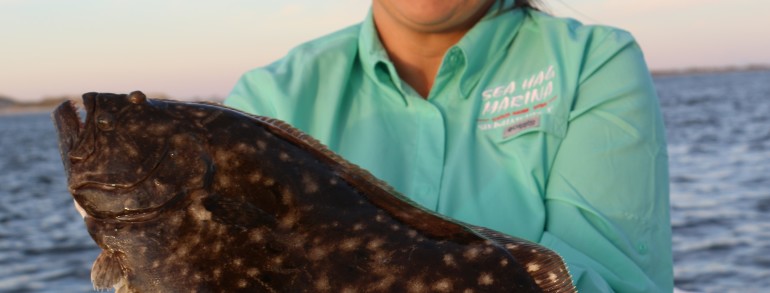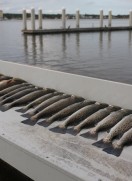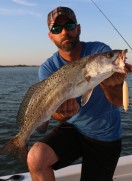"Southern Flounder 101"
It's that time of year again. Winds have started blowing out of the Northeast, water temperatures have fallen into the low 70's, and we're breaking out the Winter clothes. In Northeast Florida, Fall conditions mean one thing to anglers, Southern Flounder.
So, what makes Fall so special when targeting Flounder? It all has to do with Flounder biology. Flounder are a migratory species. During the early Summer, adult fish migrate from offshore and head for our coastal inlets and river systems. They'll spend the Summer fattening up on small fish and crustaceans in anticipation of their annual spawn. The first major cold front of October marks the start of the Fall return trip offshore. This will happen once colder northeasters start blowing in. Once water temps drop into the low 70's, Flounder will start heading for the Inlets. During the migration, they'll periodically stop to spawn. Spawning will take place in a number of areas, including creek mouths, various river shoulders, Flats, bays, or inlets. Once spawning has concluded, they'll push offshore and remain there until the following June.
Both migrations offer excellent Flounder fishing in Northeast Florida however, the Fall run is by far the most rewarding to fish. The big females tend to be easier to locate and in bigger numbers. Male fish can also be harvested however, they only grow to around 14 inches. The vast majority of harvested Flounder will always be female.
Now that we understand Flounder movements, where do we start? I start off at the furthest inshore portion of their route, where water starts to turn fresh. Keep in mind that Flounder have a high brackish water tolerance. You'll find them far up river in less salty habitat. That means you'll potentially find them in areas that also hold Large Mouth Bass, Blue Gill, and other freshwater species. In the case of the St. Johns River, we catch them as far South as the Buckman Bridge. Earlier in the Fall run, Ill start off at the furthest point of the inshore route. specifically, near Orange Park and Downtown Jacksonville. Ill hit various Flounder haunts that I've fished with success in previous seasons and work my way back towards saltier territory. I wont spend a lot of time prospecting each spot. Ill fan cast an area, if nothing bites, Ill move to the next area. Flounder are very aggressive feeders and will make their presence known pretty quickly if the desired forage is around.
Flounder feed on a plethora of different baits. The more common are Finger Mullet, Mud Minnows, Pilchards, live Shrimp, and artificial baits. Shrimp also head towards brackish water during the Summer and it is believed that the Shrimp run is why Flounder move so far up river. I happen to agree with this idea and will often fish live Shrimp on a jig while working brackish territory. Ill also fish soft plastic baits that mimic a live Shrimp. I've had days where they wouldn't take anything else. Flounder are aggressive but like any fish, they can and will crave certain forage at different times. Its best to have multiple options available. I'll pick up plenty of live Shrimp from the bait shop and catch Finger Mullet before heading out. This way, I have all my bases covered, increasing the odds of a good day.
Bottom type is another very important detail when Flounder fishing. Once Fall temperatures start dropping, Flounder will head for softer mud bottoms with shallower water. Mud holds heat better than shell or rocky bottom and Flounder will be drawn to it like a Moth to a light. In the morning, when the suns too low to heat up the flats, Flounder will sit further away from banks in deeper water. As the sun moves higher into the morning sky, mud will begin to heat up and Flounder will move towards the shallows to warm up. Based on this behavior, during low light periods,(early mornings or cold cloudy days) I'll fish deeper holes or drop offs as well as deep water structure. On sunny days, Ill head for shallow mud bottom.
Now that we know "when" and "where", lets talk a bit about "how". A good day of Flounder fishing requires covering a lot of ground. You'll be fan casting areas, dragging the bait along the bottom back towards the boat. You can dead stick baits on the bottom and do well enough, however, Flounder are often stationary and I find fishing for them to be more productive when I bring the bait to them. By casting a bait out and slowly working it back towards the boat, you increase your chances of crossing paths with a fish. Cast the rig out, and bring the bait back in slowly. If a Flounder grabs the bait, you'll usually feel a thump or a series of vibrations on the end of the line. Once this happens, pause, and take some of the tension off the line. Once a Flounder grabs a bait, especially a live Mullet, Pilchard, or Mud Minnow, they'll take a fair amount of time to swallow it. They tend to hit the bait from behind, settle back to the bottom, and then reposition the bait so that it can be swallowed head first. This process can take as long as a full minute. The bigger the bait, the longer the process can take. Everybody has a different opinion on this and I've heard of anglers waiting close to five minutes. There's an old saying and it goes "Once you feel the thump, smoke a cigarette, then set the hook". The bottom line, they take a good minute at a minimum when fishing live baits.
Another important detail when targeting Flounder is rigging. There are a number of productive rigging options that work well when targeting Flounder. My personal favorite is the Carolina Rig or Fish Finder Rig. Ill use the lightest Egg Weight I can get away with. Heavier weights will sink into the mud and create too much drag when working the rig along the bottom. This is something you'll want to limit as much as you can. A Flounder bite can be pretty subtle, often times resembling a sensation of weight or friction at the end of the line. Lighter weights dig in much less and slide along the surface of the mud smoother. The smoother the rig slides, the more obvious a Flounder bite will feel. This will also limit snagging in bottom structure.
Hook type is just as important. The two most popular hook types for Flounder are wide gapped hooks and Kahle style hooks. My personal favorite is definitely the Kahle. They hang up in the bottom less and hold live bait better than most hooks. Ill use Hooks from 1/0 to 3/0 in size. Bait type will play a factor when selecting your hook. When fishing Finger Mullet, Ill use a 3/0, when fishing smaller, more fragile baits such as Mud Minnows and Pilchards, Ill go with a 1/0 hook.
Flounder fishing will require a bit of patience and a willingness to cover a lot of ground. But, make no mistake, once you start dialing in on them, you'll be hooked for life.
Jacksonville Fishing charters. Jacksonville charter fishing. Guide fishing Jacksonville. Fishing guides Jacksonville. Charter fishing Jacksonville. Jacksonville Sport Fishing. Sport Fishing Jacksonville. Mayport charter fishing. Mayport Sport Fishing.





admin
Danny Pardue